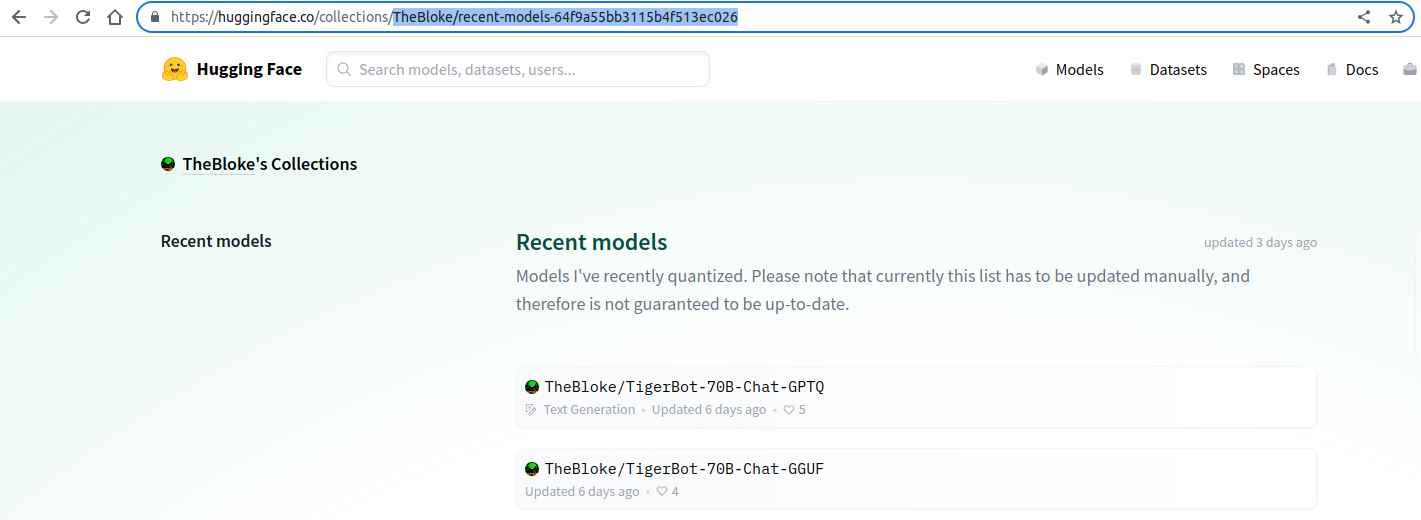集合(Collections)
集合(collection)是 Hub 上将一组相关项目(模型、数据集、Spaces、论文)组织在同一页面上的一种方式。利用集合,你可以创建自己的作品集、为特定类别的内容添加书签,或呈现你想要分享的精选条目。要了解更多关于集合的概念及其在 Hub 上的呈现方式,请查看这篇 指南
你可以直接在浏览器中管理集合,但本指南将重点介绍如何以编程方式进行管理。
获取集合
使用 get_collection() 来获取你的集合或任意公共集合。 你需要提供集合的 slug 才能检索到该集合。 slug 是基于集合标题和唯一 ID 的标识符。你可以在集合页面的 URL 中找到它。

让我们获取"TheBloke/recent-models-64f9a55bb3115b4f513ec026"这个集合:
>>> from huggingface_hub import get_collection
>>> collection = get_collection("TheBloke/recent-models-64f9a55bb3115b4f513ec026")
>>> collection
Collection(
slug='TheBloke/recent-models-64f9a55bb3115b4f513ec026',
title='Recent models',
owner='TheBloke',
items=[...],
last_updated=datetime.datetime(2023, 10, 2, 22, 56, 48, 632000, tzinfo=datetime.timezone.utc),
position=1,
private=False,
theme='green',
upvotes=90,
description="Models I've recently quantized. Please note that currently this list has to be updated manually, and therefore is not guaranteed to be up-to-date."
)
>>> collection.items[0]
CollectionItem(
item_object_id='651446103cd773a050bf64c2',
item_id='TheBloke/U-Amethyst-20B-AWQ',
item_type='model',
position=88,
note=None
)get_collection() 返回的 Collection 对象包含以下信息:
- 高级元数据:
slug,owner,title,description等。 - 一个
CollectionItem对象列表; 每个条目代表一个模型、数据集、Space 或论文。
所有集合条目(items)都保证具有:
- 唯一的
item_object_id: 这是集合条目在数据库中的唯一 ID - 一个
item_id: Hub 上底层条目的 ID(模型、数据集、Space、论文);此 ID 不一定是唯一的,仅当item_id与item_type成对出现时才唯一 - 一个
item_type: 如model,dataset,Space,paper - 该条目在集合中的
position, 可通过后续操作 (参加下文的update_collection_item())来重新排序集合条目
此外,note 可选地附加在条目上。这对为某个条目添加额外信息(评论、博客文章链接等)很有帮助。如果条目没有备注,note 的值为 None。
除了这些基本属性之外,不同类型的条目可能会返回额外属性,如:author、private、lastModified、gated、title、likes、upvotes 等。这些属性不保证一定存在。
列出集合
我们也可以使用 list_collections()来检索集合,并通过一些参数进行过滤。让我们列出用户teknium的所有集合:
>>> from huggingface_hub import list_collections
>>> collections = list_collections(owner="teknium")这将返回一个 Collection 对象的可迭代序列。我们可以遍历它们,比如打印每个集合的点赞数(upvotes):
>>> for collection in collections:
... print("Number of upvotes:", collection.upvotes)
Number of upvotes: 1
Number of upvotes: 5当列出集合时,每个集合中返回的条目列表最多会被截断为 4 个。若要检索集合中的所有条目,你必须使用 get_collection().
我们可以进行更高级的过滤。例如,让我们获取所有包含模型 TheBloke/OpenHermes-2.5-Mistral-7B-GGUF 的集合,并按照趋势(trending)进行排序,同时将结果限制为 5 个。
>>> collections = list_collections(item="models/TheBloke/OpenHermes-2.5-Mistral-7B-GGUF", sort="trending", limit=5):
>>> for collection in collections:
... print(collection.slug)
teknium/quantized-models-6544690bb978e0b0f7328748
AmeerH/function-calling-65560a2565d7a6ef568527af
PostArchitekt/7bz-65479bb8c194936469697d8c
gnomealone/need-to-test-652007226c6ce4cdacf9c233
Crataco/favorite-7b-models-651944072b4fffcb41f8b568sort 参数必须是 "last_modified"、"trending" 或 "upvotes" 之一。item 参数接受任意特定条目,例如:
"models/teknium/OpenHermes-2.5-Mistral-7B""spaces/julien-c/open-gpt-rhyming-robot""datasets/squad""papers/2311.12983"
详情请查看 list_collections() 的参考文档。
创建新集合
现在我们已经知道如何获取一个 Collection, 让我们自己创建一个吧! 使用 create_collection(),传入一个标题和描述即可。 若要在组织(organization)名下创建集合,可以通过 namespace="my-cool-org" 参数指定。同样,你也可以通过传入 private=True 创建私有集合。
>>> from huggingface_hub import create_collection
>>> collection = create_collection(
... title="ICCV 2023",
... description="Portfolio of models, papers and demos I presented at ICCV 2023",
... )该函数会返回一个包含高级元数据(标题、描述、所有者等)和空条目列表的 Collection 对象。现在你可以使用返回的 slug 来引用该集合。
>>> collection.slug
'owner/iccv-2023-15e23b46cb98efca45'
>>> collection.title
"ICCV 2023"
>>> collection.owner
"username"
>>> collection.url
'https://huggingface.co/collections/owner/iccv-2023-15e23b46cb98efca45'管理集合中的条目
现在我们有了一个 Collection,接下来要添加条目并进行管理。
添加条目
使用 add_collection_item() 来向集合中添加条目(一次添加一个)。你只需要提供 collection_slug、item_id 和 item_type。可选参数 note 用于为该条目添加附加说明(最多 500 个字符)。
>>> from huggingface_hub import create_collection, add_collection_item
>>> collection = create_collection(title="OS Week Highlights - Sept 18 - 24", namespace="osanseviero")
>>> collection.slug
"osanseviero/os-week-highlights-sept-18-24-650bfed7f795a59f491afb80"
>>> add_collection_item(collection.slug, item_id="coqui/xtts", item_type="space")
>>> add_collection_item(
... collection.slug,
... item_id="warp-ai/wuerstchen",
... item_type="model",
... note="Würstchen is a new fast and efficient high resolution text-to-image architecture and model"
... )
>>> add_collection_item(collection.slug, item_id="lmsys/lmsys-chat-1m", item_type="dataset")
>>> add_collection_item(collection.slug, item_id="warp-ai/wuerstchen", item_type="space") # same item_id, different item_type如果一个条目已存在于集合中(相同的 item_id 和 item_type),将会引发 HTTP 409 错误。你可以通过设置 exists_ok=True 来忽略此错误。
为已存在条目添加备注
你可以使用 update_collection_item() 来为已存在条目添加或修改备注。让我们重用上面的示例:
>>> from huggingface_hub import get_collection, update_collection_item
# Fetch collection with newly added items
>>> collection_slug = "osanseviero/os-week-highlights-sept-18-24-650bfed7f795a59f491afb80"
>>> collection = get_collection(collection_slug)
# Add note the `lmsys-chat-1m` dataset
>>> update_collection_item(
... collection_slug=collection_slug,
... item_object_id=collection.items[2].item_object_id,
... note="This dataset contains one million real-world conversations with 25 state-of-the-art LLMs.",
... )重新排序条目
集合中的条目是有序的。该顺序由每个条目的 position 属性决定。默认情况下,新添加的条目会被追加到集合末尾。你可以通过 update_collection_item() 来更新顺序。
再次使用之前的示例:
>>> from huggingface_hub import get_collection, update_collection_item
# Fetch collection
>>> collection_slug = "osanseviero/os-week-highlights-sept-18-24-650bfed7f795a59f491afb80"
>>> collection = get_collection(collection_slug)
# Reorder to place the two `Wuerstchen` items together
>>> update_collection_item(
... collection_slug=collection_slug,
... item_object_id=collection.items[3].item_object_id,
... position=2,
... )删除条目
最后,你也可以使用 delete_collection_item() 来删除集合中的条目。
>>> from huggingface_hub import get_collection, update_collection_item
# Fetch collection
>>> collection_slug = "osanseviero/os-week-highlights-sept-18-24-650bfed7f795a59f491afb80"
>>> collection = get_collection(collection_slug)
# Remove `coqui/xtts` Space from the list
>>> delete_collection_item(collection_slug=collection_slug, item_object_id=collection.items[0].item_object_id)删除集合
可以使用 delete_collection() 来删除集合。
此操作不可逆。删除的集合无法恢复。
>>> from huggingface_hub import delete_collection
>>> collection = delete_collection("username/useless-collection-64f9a55bb3115b4f513ec026", missing_ok=True)